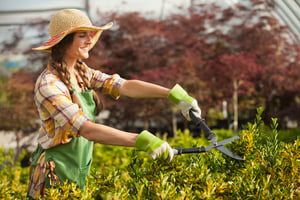 Gardening is one of the best ways to exercise and enjoy the outdoors. Many studies have shown gardening can reduce stress, strengthen your heart, and improve your mood. You can grow plants and play in the dirt as well.
Gardening is one of the best ways to exercise and enjoy the outdoors. Many studies have shown gardening can reduce stress, strengthen your heart, and improve your mood. You can grow plants and play in the dirt as well.
Before you grab your trowel and head outside, it's crucial to remember that gardening exposes you to many potential hazards, like weather, bees, and strenuous physical activity. Taking time to prepare yourself for potential risks will make your gardening experience safe and enjoyable.
Here are a few hazards to watch for when you’re in the garden.
Weather-Related Hazards
1. Sunburn.
The warm weather and sunshine feel good in spring. Still, unprotected skin can quickly become sunburned if sunscreen isn’t applied. You should apply sunscreen to all parts of your skin exposed to sunlight and then, reapply every two hours. It's crucial to use a broad-spectrum sunscreen with an SPF value of at least 15.
2. Heat.
Extreme heat can cause dehydration, heat exhaustion, and heatstroke. To minimize your exposure to extreme heat, work in the garden early or late in the day when the temperatures are cooler. You should take frequent breaks and drink plenty of water. Knowing the symptoms of heat exhaustion and heatstroke is very important during summer.
Symptoms
| Heat Exhaustion | Heat Stroke |
| Feeling dizzy or faint | Confusion |
| Excessive sweating | Throbbing headache |
| Cool, clammy skin | Red, dry skin |
| Vomiting or nausea | Vomiting or nausea |
| Weak, rapid pulse | Strong, rapid pulse |
| Muscle cramps | Loss of consciousness |
How to Respond
| Move to a cooler place and rehydrate, take a cool shower | Call 9-1-1 Move to a cool, shaded location |
3. Dehydration.
Be sure to consistently take breaks and drink water, especially during extreme heat. Symptoms of dehydration include extreme thirst, fatigue, dizziness, and headache.
Physical hazards
1. Lifting and bending.
Gardening has no shortage of bending and lifting. Remember to lift with your legs and hold items close to you when lifting. Bending can strain your back, so try kneeling to reduce the strain, and use kneepads. Take some time to stretch before and after working in the garden.
2. Repetitive motion.
Many gardening tasks involve repetition. Performing the same task several times may cause skin or nerve irritation. Changing tasks every 15-30 minutes will reduce these irritations.
3. Protect your hands.
You should wear gloves to prevent blisters, cuts, and harmful fungi from entering your body. Gloves protect your hands from sharp tools as well.
4. Bees.
You should be aware of any bees present in the garden. Bees are usually only aggressive when they feel threatened, so be aware of your surroundings and keep your distance. Ensure you have access to a first aid kit if a bee or other insect stings you. Seek emergency treatment if you or someone else is having an allergic reaction to a sting.
5. Chemicals.
Whether applying fertilizers or pesticides, you should always wear proper protective equipment when handling chemicals. You can absorb chemicals through the skin, so wear clothing that covers your arms and legs. Anytime you apply a chemical, follow the instructions on the label. Following the label will minimize your exposure to chemicals and allow the product to function correctly.
6. Power equipment.
Gardening often involves using power tools like hedge trimmers and leaf blowers. You should avoid operating equipment near other people and always wear hearing and eye protection. It's good to check the owner’s manual to ensure you’re operating equipment correctly.Being aware of these potential hazards will allow you to garden safely and reap the rewards of gardening.
Author Bio: Matthew Olson is a professional horticulturist and garden writer. He has a bachelor’s degree in horticulture from UW-River Falls and is a certified professional with the Minnesota Nursery and Landscape Association. His enthusiasm for plants and the outdoors brought him to the green industry. He regularly writes articles about gardening for both gardeners and industry professionals. He can be reached at matt@mattolsonhorticulture.com.





